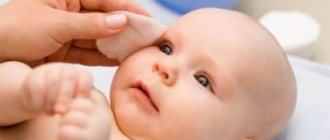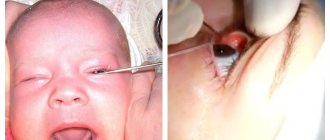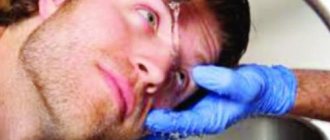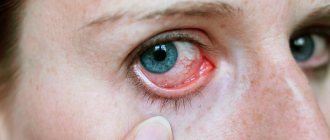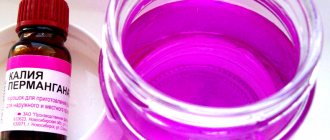Conjunctivitis is a disease that can occur in both adults and children. But in the latter it occurs much more often, especially in bacterial form. The disease may go away on its own without special treatment, but in this case there is a risk of developing a number of complications, especially in children, so it is important to know what to use to wash the eyes with conjunctivitis in children and how to defeat this disease.
How to wash eyes for conjunctivitis in children
A few words about the disease
Conjunctivitis is a disease that is familiar to many firsthand. Almost all people, with different types, have encountered it. It occurs due to exposure of the mucous membranes of the eyes to pathogens of various diseases (microorganisms, viruses, etc.).
How is conjunctivitis transmitted?
Conjunctivitis tends to be more common in children than in adults, especially in the bacterial form. This is due to the fact that a child’s immune system is much more vulnerable than that of an adult , and also due to the fact that children are more actively in contact with the environment and think less about hygiene. Their bodies can easily be affected by any viruses. And with dirty hands they often begin to rub their eyes, introducing infection into them.
Children are more likely to get conjunctivitis
On a note! In general, conjunctivitis can be caused by bacteria, viruses, or due to eye injury or exposure to any allergen. Sometimes conjunctivitis accompanies all kinds of colds.
In infants under the age of 1 year, conjunctivitis can appear due to infection while still in the womb or during delivery. Also, sometimes it is a secondary disease that develops against the background of the so-called dacryocystitis, in which there is obstruction of the lacrimal canals.
Purulent conjunctivitis of the eyes
Treatment with traditional methods
An accurate diagnosis should be entrusted to an ophthalmologist, then the treatment will be effective and the recovery period in children will be as fast as possible.
The most effective way when the baby’s vision organs are inflamed is eye drops. They are prescribed depending on what factors influenced the onset of the disease.
If there is a bacterial infection or a cold, then it is necessary to treat it with drops of drugs with an antibiotic substance. If there are problems with the tear ducts in a newborn, drops will be prescribed whose composition resembles human tears.
Symptoms and diagnosis
The symptoms of conjunctivitis are quite specific; it is quite easy to identify even without contacting an ophthalmologist. Among the signs of the disease are:
- severe redness of the white part of the eyes;
- swelling of the eyelids, puffiness;
- severe lacrimation;
- purulent or other type of discharge from the eyes;
- the formation of dried masses of pus on the eyelashes at night;
- photophobia;
- general deterioration of condition;
- itching, burning and other unpleasant sensations;
- blurred vision.
Purulent discharge from the eyes
On a note! If the eyes begin to fester severely, then most likely it is a bacterial form of conjunctivitis.
Very young children can also become too capricious, lethargic, and cry a lot. Older children begin to eat poorly, complain of blurred vision and a feeling of sand in the eyes.
But for an accurate diagnosis and determination of the nature of the disease, in any case you need to consult a doctor. Only he can prescribe the most effective treatment. The doctor interviews the patient or his parents, conducts a thorough eye examination, and tries to identify any additional symptoms or prerequisites for the development of the disease.
Is conjunctivitis contagious in children?
On a note! To identify the causative agent of conjunctivitis, an ophthalmologist may prescribe a smear examination of the mucous membrane or tests to identify allergens.
Why does eye inflammation occur in children?
Depending on the pathogen, viral, bacterial, fungal, allergic, and chlamydial inflammation of the eye are distinguished. The causative agents of bacterial inflammation in children are more often:
- staphylococci,
- streptococci,
- pneumococci,
- gonococci,
- coli,
- Koch bacilli
- and diphtheria.
Depending on the pathogen, viral, bacterial, fungal, allergic, and chlamydial inflammation of the eye are distinguished. The causative agents of bacterial inflammation in children are more often:
- staphylococci,
- streptococci,
- pneumococci,
- gonococci,
- coli,
- Koch bacilli
- and diphtheria.
Types and forms
Conjunctivitis can be caused by various reasons and phenomena, which is why it has several forms. For example, if the disease developed suddenly, then most likely we are talking about acute conjunctivitis. If the character is chronic, then its symptoms do not develop as actively. Usually the chronic form is not observed in children, but sometimes it is a concomitant disease with allergies.
Main types of disease
Table. Types of conjunctivitis.
| View | Description |
| Viral | In this case, the causative agent of the disease is an adenovirus, which can also cause the development of pharyngitis. This type of conjunctivitis can also be caused by the herpes virus or enterovirus. The disease is contagious and can spread very quickly within one social circle (for example, in a group in a kindergarten or family). It is transmitted through close contact between an infected person and a healthy person, as well as through toys, etc. |
| Bacterial | This type of conjunctivitis is often caused by streptococci, staphylococci or pneumococci, that is, pathogenic microorganisms. For the growth of their populations, a favorable environment is required, which is formed with insufficient personal hygiene. Also, weakened immunity can cause the development of this form of the disease. Sometimes the causative agents are gonococci or chlamydia, which enter the baby's eyeball when passing through the mother's birth canal. Older children usually contract bacterial conjunctivitis at home. |
| Allergic | The mucous membrane of the eyes of a number of people reacts sharply to certain substances that may be allergens. This could be plant pollen, secretions secreted by animal skin, etc. Upon contact with allergens, allergic conjunctivitis develops, which is often accompanied by rhinitis. |
Allergic conjunctivitis
You can also distinguish other forms of conjunctivitis - follicular, catarrhal, membranous . As a rule, it is the catarrhal form that is easiest to cure, since the disease is mostly superficial. With follicular conjunctivitis, a number of vesicles-follicles measuring up to 2 mm are formed on the mucous membrane. And with the membranous form, the eyeball is covered with a cloudy whitish or grayish film. It is easily removed, but ulcers may form in the places where it is attached to the mucous membrane.
Outcome of the membranous form of adenoviral conjunctivitis
Treatment
Treatment of conjunctivitis is not as difficult as it seems. But the greatest effectiveness from the methods used can be obtained if you know exactly the type of disease. As a rule, drops, ointments, and various eye wash compositions are used for therapeutic purposes. Systemic medications can also be prescribed that will have a complete effect on the body. Bacterial conjunctivitis is treated with antibiotics that have a targeted or general effect.
Treatment of conjunctivitis in a child
Attention! Antibiotics are drugs that have a strong effect on the human body. Under no circumstances should a child be prescribed them independently. Only a doctor can write a prescription for this type of medication.
For children under 1 year of age, the doctor may prescribe drops such as Vitabact, Levomycetin, Albucid. For an uncomplicated viral form of the disease, interferon-based drops are sometimes used to help maintain and enhance local immunity. If conjunctivitis is caused by allergies, then antihistamines are prescribed.
Vitabact
Before instilling or using ointments, it is imperative to clean the eyes, the skin around them and the mucous membranes from pus. You need to put drops in your child's eyes from bottles with soft spouts to avoid injury. Drops should be applied to both eyes, even if only one is affected by conjunctivitis. Ointments are placed in the area formed during retraction of the lower eyelid.
How to wash your eyes?
For viral or bacterial conjunctivitis, the ophthalmologist usually prescribes eye rinsing in addition to the use of medications. Washing is carried out every 2-3 hours. To do this, you can use chamomile decoction or Furacilin solution. The latter is prepared at the rate of 1 tablet per 0.5 glass of water at room temperature. When the symptoms of the disease begin to lose their intensity, you can wash your eyes less often - three times a day will be enough.
Chamomile decoction
Sometimes it is enough to use boiled water to wash your eyes. The main thing is that it is clean and not hot.
On a note! For allergic conjunctivitis, eye rinsing is not prescribed.
Washing a child's eyes
When washing, sterile gauze wipes , and it is important to use a clean one for each eye, especially if only one eye is affected by conjunctivitis. You need to move the gauze napkin soaked in the solution in the direction from the temple to the nose. The solution prepared for washing the eyes can also be used to wash the face.
Solutions for these procedures should only be prepared using boiled water, which should cool to room temperature. All items used to manipulate the eyes (droppers, swabs, etc.) must also be clean. The solution ready for washing must be filtered from small particles through a piece of sterile gauze.
Both eyes need to be rinsed
Among the folk remedies used for washing the eyes, in addition to the chamomile solution, one can note oak bark, calendula or aloe. These products have a pronounced antibacterial effect, relieve swelling, relieve burning and redness of the eyes.
A solution based on aloe vera is prepared as follows: 5 leaves are washed with clean water and poured with 0.5 liters of boiling water, then infused for several hours. This solution is used at least 3 times during the day.
Video - How to wash your eyes?
Eye wash for conjunctivitis
Treatment of conjunctivitis in children at home should begin with rinsing. For this purpose, pharmaceutical preparations with disinfecting properties are used. Among them are “Furacilin”, “Miramistin”, “Albucid”. Boric acid and a weak solution of manganese are suitable.
You can prepare the infusion yourself. For this you will need dried herbs. Chamomile is usually used. Its flowers have soothing and anti-inflammatory properties. To prepare the product, pour one tablespoon of chamomile flowers into a glass of boiling water and leave for 15-20 minutes. In the same way, homemade infusions are made from sage, cornflower, and calendula.
If there are no pharmaceutical herbs at hand, black and green tea are used. The tea leaves are mixed in equal proportions. The infusion should not be strong. This rule also applies to other decoctions that are prepared at home. Recipes may contain different amounts of ingredients, so you need to carefully monitor the consistency of the infusion.
The prepared solutions are filtered so that particles of herbs do not get into the child’s eyes.
Aloe will help fight conjunctivitis at home. Use plant juice diluted with boiled water in proportions of one to ten. Aloe juice can also be used as eye drops. Then it needs to be diluted with water in a one to one ratio.
When washing, you should follow a few simple rules:
- before washing, wash your hands thoroughly with soap and cut your nails short;
- It is better to rinse your eyes with liquid at room temperature;
- both eyes are washed even in cases where the symptoms of the disease appear in only one;
- different cotton pads are used for each eye;
- movements are made from the outer corner of the eye towards the bridge of the nose;
- The liquid remaining on the eyes is removed with a clean, dry cloth.
During rinsing, all dried crusts are removed from the eyes if there is purulent discharge. If the cause of eye inflammation is an allergy, then rinsing is not prescribed.
Prevention
To reduce the risk of developing conjunctivitis, a number of preventive measures are required. It is important to monitor the child’s immunity and give him vitamins during periods of vitamin deficiency. Nutrition should be balanced and of high quality. The main preventive measure is personal hygiene, as well as a healthy lifestyle with frequent walks. It is important to wash your hands as often as possible throughout the day using soap. In a house where a very small child lives, wet cleaning is required frequently.
The child should wash his hands as often as possible

